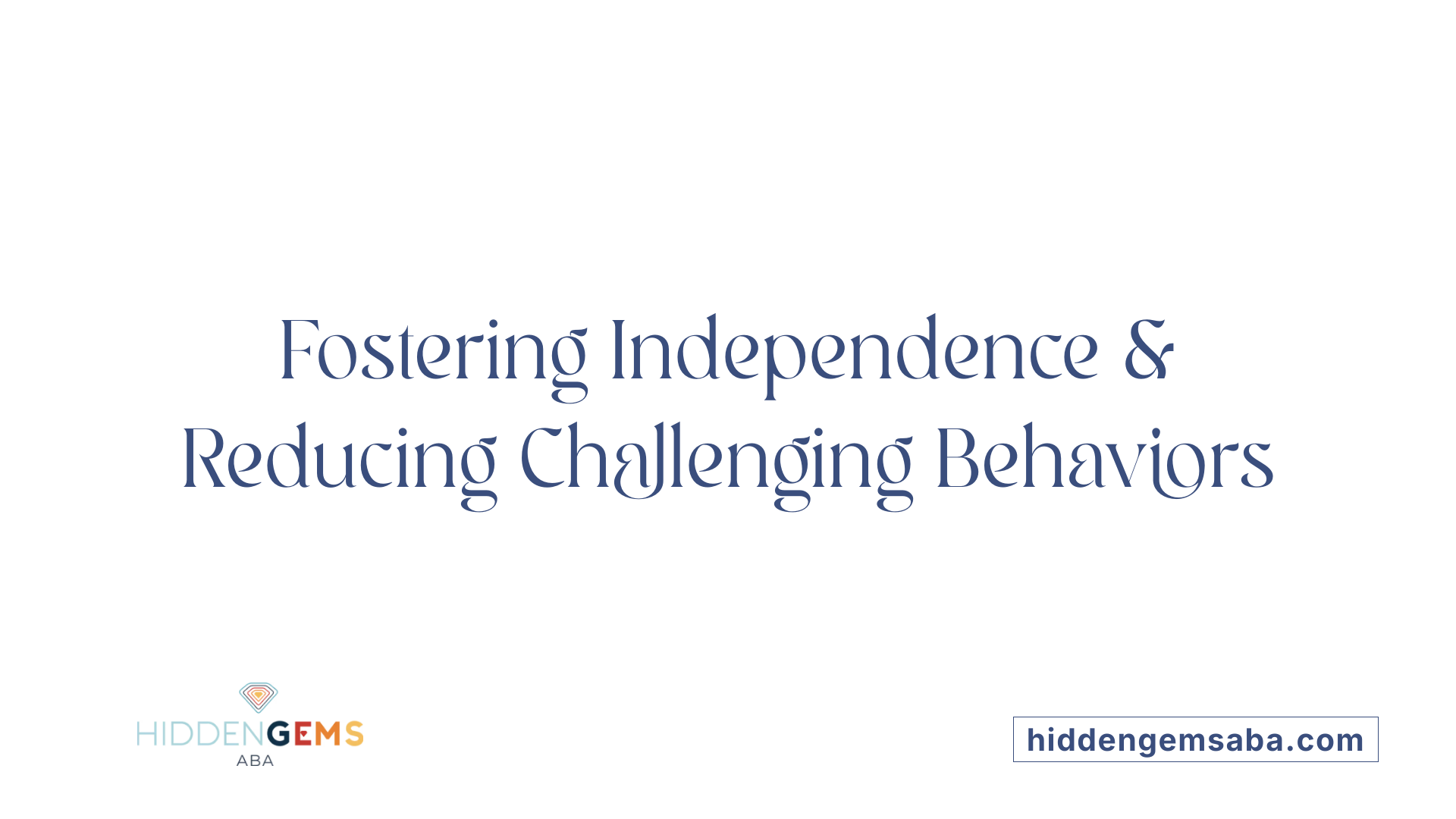Understanding the Role of ABA in Social Development
Autism Spectrum Disorder (ASD) presents unique challenges in social interactions, often affecting children’s ability to negotiate, resolve conflicts, and build meaningful peer relationships. Applied Behavior Analysis (ABA) emerges as a scientifically supported approach that helps tailor interventions to individual needs. This article explores how ABA therapy enhances social skills, facilitates peer negotiation and conflict resolution, and ultimately fosters positive peer relationships.
How ABA Therapy Improves Social Skills and Peer Interactions

How does ABA therapy improve social skills and peer interactions?
ABA therapy enhances social skills and peer interaction abilities through a variety of structured and personalized methods rooted in behavioral science. Therapists develop individualized intervention plans that focus on specific social challenges faced by each child, ensuring that strategies are relevant and effective.
A core part of ABA's approach involves teaching children to understand social cues and respond appropriately in different scenarios. Techniques such as social stories provide visual and narrative guidance to help children grasp social norms and expected behaviors.
Role-playing activities allow children to practice social interactions in a safe and controlled environment. For example, children might practice greeting peers, taking turns, or sharing toys, which helps them build confidence and competence in real-world settings.
Video modeling uses videos of peers or adults demonstrating desirable social behaviors, which children can imitate. Social scripts are prepared phrases or dialogues that children can use during conversations or social exchanges, reducing anxiety and uncertainty.
Reinforcement strategies play a vital role in encouraging positive social behaviors. When a child appropriately interacts with a peer or uses a new skill, immediate praise or other rewards strengthen the likelihood of continued positive behavior.
Beyond basic social interactions, ABA therapy also targets broader skills such as emotional regulation, turn-taking, and conflict resolution. Skills like recognizing and managing emotions are trained to help children navigate social relationships more effectively.
The success of social skills development in ABA depends heavily on collaboration. Therapists often work closely with parents, teachers, and caregivers to reinforce learned behaviors across multiple environments. This consistency helps children transfer skills from therapy sessions to school, home, and community settings.
Overall, ABA therapy helps children with autism to better understand social cues, increase peer engagement, and develop meaningful relationships. Through systematic teaching and reinforcement, children learn how to initiate conversations, interpret social signals, and sustain social interactions, significantly improving their social well-being.
Strategies in ABA for Peer Negotiation and Conflict Management

What are common strategies used in ABA therapy to enhance peer negotiation and conflict management?
ABA therapy employs a variety of effective strategies to help children with autism develop skills necessary for positive peer interactions, conflict resolution, and negotiation. These techniques focus on systematically teaching and reinforcing social behaviors that facilitate healthier and more productive interactions.
One foundational approach involves teaching communication skills through role-playing, modeling, and social stories. Role-playing allows children to practice conflict scenarios in a safe, controlled environment, giving them confidence and clarity in handling real-life situations. Modeling involves demonstrating appropriate behaviors, which children then imitate, reinforcing the correct responses. Social stories serve as visual narratives that depict step-by-step processes for resolving conflicts or initiating negotiations, making complex social rules more understandable.
Reinforcement strategies play a critical role in encouraging the consistent practice of skills. By providing positive feedback when children demonstrate negotiation, sharing, or calming behaviors, therapists and caregivers motivate continued use of these skills. Reinforcement can include praise, tokens, or other preferred items that make practicing social skills rewarding.
To establish correct responses, ABA therapists often utilize prompting hierarchies—starting with full assistance and gradually fading prompts as independence increases. Error correction procedures ensure that children learn from mistakes without reinforcing undesirable behaviors.
Additionally, teaching precurrent behaviors—simple precursor actions that lead to more complex social interactions—is vital. These include making eye contact, greeting peers, or taking turns. Social rules, such as waiting patiently or using polite language, are explicitly taught to build socially appropriate responses.
Perspective-taking exercises are integrated into therapy to help children understand others' feelings and viewpoints, a crucial skill for resolving conflicts empathetically. Using problem-solving worksheets with multiple exemplars provides concrete tools to practice identifying issues, generating solutions, and applying conflict-resolution strategies across various settings.
Creating social skills groups offers natural opportunities for peer interaction. These groups facilitate real-world practice, allowing children to observe and emulate positive social behaviors, negotiate, and resolve disagreements in a supportive environment.
Involving families in these interventions ensures that skills are reinforced consistently across home and community settings. Tailoring strategies to each child's unique social needs maximizes their effectiveness and promotes enduring improvements in peer relationships.
Below is a summary table of these strategies:
| Strategy | Description | Benefits |
|---|---|---|
| Role-playing | Practice conflict scenarios actively | Builds confidence and response flexibility |
| Modeling | Demonstrate appropriate behaviors visually | Enhances imitation and understanding |
| Social stories | Visual step-by-step guides | Clarifies social expectations |
| Reinforcement | Positive feedback for desired behaviors | Motivates ongoing skill use |
| Prompting hierarchy | Gradually fade assistance | Promotes independent responses |
| Error correction | Correct responses without reinforcement of mistakes | Reinforces learning from errors |
| Teaching precurrent behaviors | Simple behaviors leading to complex skills | Lays foundation for social interactions |
| Social rules training | Explicit teaching of polite and respectful behaviors | Improves social appropriateness |
| Perspective-taking | Understanding others' feelings and views | Fosters empathy and conflict resolution |
| Problem-solving worksheets | Practice resolving conflicts with varied examples | Generalizes skills to different contexts |
| Peer social groups | Facilitate natural interaction | Supports skill generalization and social confidence |
By combining these strategies, ABA therapy creates a comprehensive framework that equips children with autism with the skills needed for effective peer negotiation and conflict management. Consistent application and personalized adaptations ensure that these skills translate into meaningful social relationships and improved quality of life.
The Effectiveness of ABA in Addressing Social Challenges
How effective is ABA therapy in addressing social challenges faced by children with autism?
Applied Behavior Analysis (ABA) therapy has shown to be highly effective in helping children with autism overcome social challenges. It is a science-backed approach that focuses on improving social engagement, communication, and conflict resolution skills.
One of the reasons for its success is the personalized nature of ABA programs. Therapists conduct comprehensive assessments to identify each child's specific social skill gaps and then develop tailored goals. These goals often include learning how to make eye contact, initiate conversations, or take turns during play.
ABA techniques such as role-playing and modeling are widely used to practice social interactions in a controlled setting. These activities boost children's confidence and prepare them for real-world situations.
Visual supports, like picture schedules and social stories, help children understand social cues and routines better. Reinforcement strategies, including praise or rewards, encourage the repetition of positive social behaviors.
Group training sessions and naturalistic teaching approaches allow children to generalize these skills across various environments like school, playground, or community settings. This broad application is critical for meaningful social integration.
Early intervention and intensive therapy are associated with significantly improved results. Children who start ABA early tend to develop stronger social bonds and participate more actively in peer interactions.
Research from multiple scientific studies and endorsements from autism organizations confirm that ABA enhances social skills, reduces social difficulties, and promotes independence in children with ASD.
| Aspect of ABA | Focus Area | Benefit |
|---|---|---|
| Personalization | Tailored goals based on assessment | Meets individual needs for better outcomes |
| Social Skill Training | Role-playing, modeling | Practical experience in social contexts |
| Visual Supports | Picture schedules, social stories | Better understanding of social cues |
| Reinforcement Strategies | Rewards, praise | Encouragement for desired behaviors |
| Generalization | Group activities, natural settings | Application of skills across settings |
| Early Intervention | Starting therapy early | Improved developmental trajectories |
In summary, ABA is a proven, effective method that directly targets social challenges faced by children with autism, helping them develop essential social skills necessary for everyday life and fostering better peer relationships.
Facilitating Better Peer Negotiation and Conflict Resolution with ABA
Can ABA therapy facilitate better peer negotiation and conflict resolution?
ABA therapy plays a significant role in enhancing social skills like peer negotiation and conflict resolution for children with autism. This approach involves structured programs that teach children specific social and problem-solving skills, often through techniques such as discrete trial training and naturalistic teaching. These methods utilize positive reinforcement to encourage desired behaviors, including effective communication, cooperation, and empathy.
An essential component of ABA is integrating emotional comprehension training. This helps children understand their own emotions and those of others, which is crucial for navigating social interactions smoothly. Studies show that children who develop better emotional awareness tend to use more constructive conflict strategies and respond less aggressively. As children grow, their improvements in emotional understanding contribute to better peer relationships.
ABA programs often include targeted elements such as peer mediation and communication skills training. Peer mediation involves teaching children how to facilitate problem-solving conversations, making conflicts less disruptive. Simultaneously, communication skills—like initiating conversations, making requests, and using social cues—are reinforced, which helps reduce misunderstandings and frustrations that can lead to disputes.
Promoting cooperative behaviors is another focus. Children learn to share, take turns, and listen actively through role-playing and modeling. These activities help build trust and encourage positive interactions, decreasing the likelihood of conflicts.
Data from research indicates that integrating emotional and social skills within ABA significantly improves children's ability to negotiate and resolve peer conflicts. It lowers aggressive responses and promotes respectful, understanding interactions. Tailoring ABA strategies to include components like emotional awareness and peer-based activities strengthens children's capacity to handle social challenges effectively.
Overall, ABA therapy, when combined with emotional comprehension training, provides children with the tools they need for healthier peer interactions. This approach not only reduces conflicts but also fosters cooperative behavior, leading to more positive social experiences and improved peer relationships.
How do these components interconnect?
| Component | Function | Impact |
|---|---|---|
| Social and problem-solving skills | Teaching children to identify issues and resolve them calmly | Reduces conflicts and encourages constructive negotiation |
| Emotional comprehension training | Helping children understand feelings of self and others | Enhances empathy, leading to better conflict management |
| Peer mediation and communication skills | Facilitating peer-led solutions and effective dialogue | Promotes cooperation, reduces misunderstandings |
| Promoting cooperative behaviors | Encouraging sharing, turn-taking, and active listening | Builds positive peer relationships, prevents conflicts |
This integrated approach ensures children develop skills necessary for successful peer interactions, ultimately fostering a more harmonious social environment.
Addressing Social Challenges and Building Relationships

How does ABA therapy improve social skills and peer interactions?
ABA therapy plays a significant role in enhancing social abilities and encouraging positive peer interactions for children with autism. Using a structured and individualized approach,ABA therapists incorporate techniques such as social stories, role-playing, and video modeling to teach children how to interpret social cues, communicate effectively, and behave appropriately in social situations.
Reinforcement strategies are central to ABA, rewarding desired social behaviors to encourage their repetition. This not only promotes skills like sharing and turn-taking but also helps in managing emotions and resolving conflicts.
Furthermore, ABA's collaborative approach involves working closely with parents, teachers, and caregivers to ensure that social skills are reinforced consistently across various settings. This comprehensive strategy enables children to develop better social understanding, engage more with peers, and foster meaningful relationships.
Improving understanding of social cues
Children learn to recognize facial expressions, body language, and tone of voice, which are vital for interpreting what others feel and need. Visual supports, such as social stories and visual schedules, help clarify social expectations and reduce anxiety about new social situations.
Initiating interactions and developing friendships
Teaching children how and when to initiate conversations or play are essential components of ABA social interventions. Role-playing different scenarios and video modeling help children practice these skills in a controlled environment, increasing their confidence to engage with peers.
Role of visual supports and social stories
Visual aids and social stories are customized tools that illustrate appropriate social behaviors and routines. They serve as visual prompts that guide children through social expectations, reducing confusion and promoting independence in social interactions.
Building social confidence and empathy
Through activities like role-playing and social scripts, children develop the confidence to participate in social activities. These practices also promote empathy by helping children recognize and respond appropriately to others’ emotions, forming the basis for deeper connections.
| Aspect | Techniques Used | Goals | Additional Notes |
|---|---|---|---|
| Recognizing social cues | Visual supports, social stories | Understand facial expressions, body language | Enhances comprehension of social signals |
| Initiating interaction | Role-play, video modeling | Encourage children to start conversations | Builds proactive social engagement |
| Developing friendships | Reinforcement, social scripts | Foster trust and friendship skills | Promotes peer bonding |
| Building confidence | Interactive activities, modeling | Boost social self-esteem | Empowers children to participate more |
| Promoting empathy | Perspective-taking exercises | Recognize and respond to others' emotions | Improves social harmony |
How does ABA therapy foster lasting social skills?
ABA therapy emphasizes skill generalization across different settings, meaning children can apply their social knowledge in schools, playgrounds, and community spaces. Role-playing and modeling build trust and familiarity, while data collection helps therapists and families monitor progress and adapt strategies accordingly.
Involving families is crucial. Training parents and caregivers ensures that the reinforcement and teaching methods are consistent at home, amplifying the positive effects of therapy.
Overall, ABA enables children with autism to better understand social cues, initiate and sustain social interactions, and form meaningful friendships. These improvements enhance their social confidence and ability to navigate diverse social environments, fostering greater independence and quality of life.
Promoting Independence and Reducing Problem Behaviors

How effective is ABA therapy in addressing social challenges faced by children with autism?
ABA therapy shows strong results in helping children with autism overcome social hurdles. It tailors strategies to each child's unique needs, focusing on enhancing social skills such as making eye contact, initiating conversations, and understanding social cues.
Therapists often use role-playing, modeling, and reinforcement techniques to teach these skills in structured settings. Visual aids and group activities further support children in practicing social behaviors across various contexts.
Early interventions tend to produce the best outcomes, enabling children to participate more fully in social situations, build friendships, and develop independence.
Extensive research confirms ABA's effectiveness in improving social engagement, reducing difficulties, and fostering positive participation in peer interactions.
Teaching self-care, following directions, problem-solving
Developing self-care routines like dressing, bathing, and eating independently is a core focus in ABA. Therapists break these tasks into manageable steps and reinforce successful completion.
Following directions is trained through repetition and clear cues, helping children respond appropriately in everyday settings.
Problem-solving skills are cultivated by teaching children to identify challenges, consider solutions, and practice appropriate responses, boosting confidence in managing daily tasks.
Developing life skills for independence
ABA strategies emphasize life skills crucial for autonomy, including dressing, hygiene, and managing personal belongings. These are taught gradually and reinforced consistently.
Using naturalistic teaching environments, therapists embed learning in real-life contexts, which helps children transfer skills beyond the therapy setting.
Some programs incorporate simulated activities like grocery shopping or cooking to promote practical independence.
Reducing aggression and self-injury
Problem behaviors such as aggression and self-injury are addressed through functional behavior assessments that identify their underlying causes.
Interventions include teaching alternative communication methods and routine-based requests to meet needs that previously prompted harmful behaviors.
Positive reinforcement and behavior plans are designed to reduce these behaviors and replace them with appropriate responses.
A case example involved a child who accessed an iPad through aggressive behaviors; ABA strategies taught him to make verbal requests, reducing aggression and increasing communication.
Involving family and caregivers in training
Family involvement is vital for consistent progress. Caregivers are trained to implement strategies at home, ensuring continuity and reinforcement.
Data collection from home helps monitor progress and tailor ongoing interventions.
Through active training, families learn to support social skills, manage behaviors, and foster independence, making therapy more effective.
| Area of Focus | Techniques Used | Outcomes Expected |
|---|---|---|
| Social skills development | Role-playing, modeling, reinforcement | Better social engagement, peer interactions, friendship building |
| Self-care and daily routines | Task analysis, naturalistic teaching | Increased independence in daily activities |
| Reducing problem behaviors | Functional behavior assessment, alternative communication | Decreased aggression and self-injury, improved communication |
| Family and caregiver involvement | Parent training, data collection, home-based strategies | Reinforced progress, better generalization of skills |
ABA therapy's comprehensive approach touches on many areas critical for independence. Its personalized, evidence-based methods support children with autism in mastering skills that improve their quality of life and social integration.
Fostering Lasting Social Competence
ABA therapy proves to be a comprehensive and adaptable intervention that significantly enhances social skills and peer interactions for children with autism. By addressing core social challenges through targeted strategies such as social stories, role-playing, and positive reinforcement, ABA empowers children to navigate peer relationships, negotiate conflicts, and develop social confidence. Its collaborative nature, involving families and educators, ensures skills are reinforced across settings, leading to more meaningful and lasting social competence. As research continues to underscore its effectiveness, ABA remains a pivotal tool in fostering social inclusion and independence for children with ASD.
References
- ABA Therapy Enhance Communication Skills in Children
- ABA Therapy for Social Skills: Building Connections
- Uncovering the Benefits of ABA Therapy for Autism
- ABA Therapy
- Expert Q&A: How ABA therapy can help with severe ...
- Developing Social Skills Through ABA Therapy for Autism
- How to Teach Social Skills Using ABA Principles
- 6 Benefits of ABA Therapy for Children with Autism
- The effectiveness of applied behavior analysis program ...






